Government Schemes: Ministry of Rural Development
Pradhan Mantri Gram Sadak Yojana
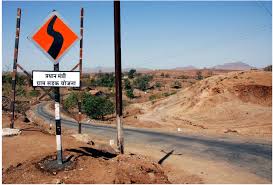
- Government have launched the Pradhan Mantri Gram Sadak Yojana on 25th December, 2000 to provide all-weather access to unconnected habitations.
- A cess is a form of tax that is levied by the government of a country to raise funds for a particular purpose.
- The Government has brought forward the target date by three years from 2022 to 2019 to achieve complete rural connectivity through all-weather roads under Pradhan Mantri Gram Sadak Yojana, PMGSY. This accelerated implementation will be achieved by providing enhanced financial allocation and through a modified funding pattern in the Scheme.
- The programme envisages connecting all eligible unconnected habitations with :
- A population of 500 persons and above in plain areas 250 persons and above in Hill States, Tribal (Schedule-V) areas, the Desert Areas (as identified in Desert Development Programme) and 82 Selected Tribal and Backward Districts under Integrated Action Plan (IAP) as identified by the Ministry of Home Affairs/Planning Commission.
- The programme also has an Upgradation component in order to ensure full farm to market connectivity.
- World Bank has supported PMGSY since its inception.
- It considers habitation as unit for providing connectivity and not a revenue village.
- The scheme encourages use of “Green Technologies” and non-conventional materials (like waste plastic, geo-textiles, fly-ash, iron and copper slag etc) for constructing rural roads.
- Funding pattern : In ratio of 60:40 between Centre and State for all States except for 8 North Eastern and 3 Himalayan States (Himachal Pradesh, Uttarakhand and Jammu & Kashmir) for which it is 90:10.
- 50% of the Cess on High Speed Diesel (HSD) is earmarked for this Programme.
Deen Dayal Upadhyaya Grameen Kaushalya Yojana
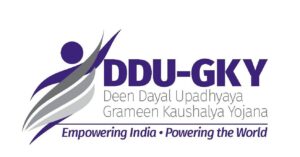
- The Ministry of Rural Development implements DDU-GKY to drive this national agenda for inclusive growth, by developing skills and productive capacity of the rural youth from poor families.
- There are several challenges preventing India’s rural poor from competing in the modern market, such as the lack of formal education and marketable skills. DDU-GKY bridges this gap by funding training projects benchmarked to global standards, with an emphasis on placement, retention, career progression and foreign placement.
Features of the scheme include:
- DDU-GKY funds a variety of skill training programs covering over 250 trades across a range of sectors such as Retail, Hospitality , Health, Construction, Automotive, Leather, Electrical, Plumbing, Gems and Jewelry, to name a few. The only mandate is that skill training should be demand based and lead to placement of at least 75% of the trainees.
- The trade specific skills are required to follow the curriculum and norms prescribed by specified national agencies: the National Council for Vocational Training and Sector Skills Councils.
- In addition to the trade specific skills, training must be provided in employability and soft skills, functional English and functional Informational technology literacy so that the training can build cross cutting essential skills.
- All program activities are subject to Standard Operating Procedures that are not open to interpretation by local inspectors. All inspections are supported by geo-tagged, time stamped videos/photographs.
Deen Dayal Antyodaya Yojana
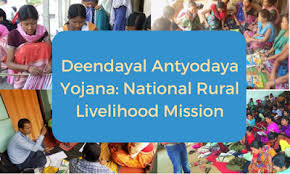
- Deen Dayal Antyodaya Yojana – National Livelihoods Mission (NRLM) was launched by the Ministry of Rural Development (MoRD), Government of India in June 2011.
- NRLM has set out with an agenda to cover 7 Crore rural poor households, across 600 districts, 6000 blocks, 2.5 lakh Gram Panchayats and 6 lakh villages in the country through self-managed Self Help Groups (SHGs) and federated institutions and support them for livelihoods collectives in a period of 8-10 years.
Key Features Include:
- Universal Social Mobilisation – At least one woman member from each identified rural poor household, is to be brought under the Self Help Group (SHG) network in a time bound manner. Special emphasis is particularly on vulnerable communities such as manual scavengers, victims of human trafficking, Particularly Vulnerable Tribal Groups (PVTGs), Persons with Disabilities (PwDs) and bonded labour. NRLM has devised special strategies to reach out to these communities and help them graduate out of poverty.
- Community Funds as Resources in Perpetuity – NRLM provides Revolving Fund (RF) and Community Investment Fund (CIF) as resources in perpetuity to the institutions of the poor, to strengthen their institutional and financial management capacity and build their track record to attract mainstream bank finance.
- Financial Inclusion – NRLM works on both demand and supply sides of financial inclusion. On the demand side, it promotes financial literacy among the poor and provides catalytic capital to the SHGs and their federations. On the supply side, the Mission coordinates with the financial sector and encourages use of Information, Communication & Technology (ICT) based financial technologies, business correspondents and community facilitators like ‘Bank Mitras’. It also works towards universal coverage of rural poor against risk of loss of life, health and assets. Further, it works on remittances, especially in areas where migration is endemic.
- Livelihoods – NRLM focuses on stabilizing and promoting existing livelihood portfolio of the poor through its three pillars – ‘vulnerability reduction’ and ‘livelihoods enhancement’ through deepening/enhancing and expanding existing livelihoods options and tapping new opportunities in farm and non-farm sectors; ‘employment’ – building skills for the job market outside; and ‘enterprises’ – nurturing self-employed and entrepreneurs (for micro-enterprises).
Aajeevika Grameen Express Yojana
- The Government of India has introduced a new sub-scheme under Deendayal Antyodaya Yojana – National Rural Livelihoods Mission (DAY – NRLM) entitled “Aajeevika Grameen Express Yojana ” (AGEY) from the financial year 2017-18.
- Objective of the scheme is to to provide safe, affordable and community monitored rural transport services to connect remote villages with key services and amenities (including access to markets, education and health) for the overall economic development of the area by making use of the supports available within the framework of DAY – NRLM.
- Under the programme, the Community Investment Fund (CIF) provided to Community based Organisations (CBOs) under the existing provisions of DAY – NRLM scheme will be utilised to support the SHG members to operate the public transport services.
Mahila Kisan Sashaktikaran Pariyojana (MKSP)
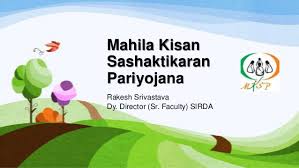
- The primary objective of the MKSP is to empower women in agriculture by making systematic investments to enhance their participation and productivity, as also create and sustain agriculture based livelihoods of rural women.
Components of the scheme include
- Organization and mobilization of women in agriculture into groups (SHGs/ Federations / Women Farmer organizations).
- Capacity building of women in Agriculture in order to enable them to manage and sustain their activities.
- Enhanced access to assets (leasing of water bodies and land etc), for the benefit of women in Agriculture as also creation of productive assets.
- Knowledge dissemination strategy, training / demonstrations, farmer-scientist interactions, exposure visits etc. of women in Agriculture in order to impart them with necessary farming skills and techniques.
- Agriculture and Allied sector activities as also the post harvest processing activities that add value to the agricultural produce.
- Improving market access and ensuring remunerative prices to women in agriculture.
- Drudgery reduction through effective use of gender – friendly tools and transfer of technologies to women in agriculture.
- Food and Nutritional security of the women in agriculture at household and community level.
- Innovative interventions for better management of risk associated with climate change.
For Tribal women engaged in Non Timber Forest produce (NTFP) collection, the components include
- Building community institutions of NTFP collectors and create social capital for creating a new business model around NTFP thereby augmenting the livelihoods of producers; increase the downstream bargaining power etc., This will be part of the major sector growth strategy by transforming the business from unorganized to organized.
- Building Private Public Panchayat Partnership (PPPP) models around select key NTFP items targeting about 10 lakh tribal house holds, by laying well defined standards and protocols of engagement between private and community organizations for procurement, storage, value addition and marketing.
- Breaking Technology barriers by effectively transferring to the producers context-specific technology, innovation/promotion o f drudgery reduction tools, value-addition technology etc. This will primarily involve scaling up the breakthroughs achieved by various agencies to take the technologies to the communities for enhanced productivity in a sustainable manner.
- Removing Information asymmetry by supplying/publishing real-time market information to all stakeholders. Besides, developing an information gateway is essential for seamless transmission of information- market, technology and training.
- Critical Investments as real value creator for creating appropriate infrastructure facilities- storage, processing; logistics, working capital management etc. VI. Enabling Policy for eliminating barriers in movement of NTFP, taxation issues etc.
Start-up Village Entrepreneurship Progam
- The Start-up Village Entrepreneurship Programme (SVEP) is being implemented as a sub-scheme under National Rural Livelihood Mission (NRLM) to promote start – up enterprises in rural areas.
- SVEP will be a focused intervention to promote start-up entrepreneurship at village level by rural poor households by providing assured availability of need based financial support, capacity building and advisory services for establishment of village enterprises.
- SVEP envisages creation of sustainable self employment opportunities for a large number of rural poor youth, enabling them to engage effectively with the market and help generate wealth locally. In the process, SVEP will bring banks and financial institutions closer to the village entrepreneur.
National Rural Livelihoods Project (NRLP)
- NRLP has been designed as a sub-set of NRLM to create ‘proof of concept’, build capacities of the Centre and States and create an enabling environment to facilitate all States and Union Territories to transit to the NRLM.
- NRLP would be implemented in 13 high poverty states accounting for about 90 percent of the rural poor in the country. Intensive livelihood investments would be made by the NRLP in 107 districts and 422 blocks of 13 states (Assam, Bihar, Chhattisgarh, Jharkhand, Gujarat, Maharashtra, Madhya Pradesh, Orissa, Rajasthan, Uttar Pradesh, West Bengal, Karnataka and Tamil Nadu). Distribution of project funds among the states would be based on inter-se poverty ratios.
Prime Minister’s Rural Development Fellowship
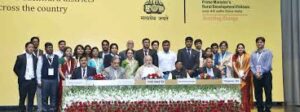
- The Prime Minister’s Rural Development Fellowship (PMRDF) is an initiative of the Ministry of Rural Development (MoRD) Government of India (GoI), implemented in collaboration with State Governments.
- The Council for Advancement of People’s Action and Rural Technology (CAPART), an autonomous institution under the Ministry of Rural Development, Government of India is the administering agency; responsible for personnel related matters of the Fellows and engagement of agencies.
- The Tata Institute of Social Sciences (TISS) is the knowledge partner; responsible for recruitment, orientation, academic programme, on-field mentorship and other support to the Fellows.
- The Fellows would need to spend time and effort in understanding the historical, geo- physical, agro – ecological, social and economic contexts of the district.
The Fellows will have mainly the following functions:
- Work with institutions of the poor to build their capacity and help them access their rights and entitlements.
- Facilitate capacity building in Self -Help Groups (SHGs), and in institutions of local democracy, like panchayats.
- Conduct socio -economic analysis of the local areas at Block level and contribute in ascertaining the felt needs of the people.
- Help the district administration in local area planning.
- Assist in better implementation of poverty alleviation programmes, particularly MGNREGA, NRLM, National Rural Drinking Water Programme, NBA, IWMP, NSAP, IAP, ICDS, NRHM SSA/RMSA etc.
- Undertake action –research to discover more appropriate ways of programme delivery by the district administration
- Design and implement innovative projects.
- Provide feedback on rural development initiatives.
Mahatma Gandhi National Rural Employment Guarantee Scheme (MNREGS)
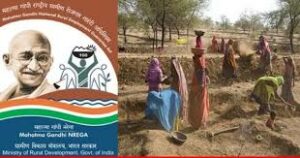
- Mahatma Gandhi National Rural Employment Guarantee Scheme (MNREGS) is Indian legislation enacted on August 25, 2005.
- The MGNREGA provides a legal guarantee for one hundred days of employment in every financial year to adult members of any rural household willing to do public work-related unskilled manual work at the statutory minimum wage. The Ministry of Rural Development (MRD), Govt of India is monitoring the entire implementation of this scheme in association with state governments.
- The objective of the Act is to enhance livelihood security in rural areas by providing at least 100 days of guaranteed wage employment in a financial year to every household whose adult members volunteer to do unskilled manual work.
Features of the Act:
- Adult members of a rural household, willing to do unskilled manual work, may apply for registration in writing or orally to the local Gram Panchayat
- The Gram Panchayat after due verification will issue a Job Card. The Job Card will bear the photograph of all adult members of the household willing to work under MGNREGA and is free of cost
- The Job Card should be issued within 15 days of application.
- The Gram Panchayat will issue a dated receipt of the written application for employment, against which the guarantee of providing employment within 15 days operates
- Employment will be given within 15 days of application for work, if it is not then daily unemployment allowance as per the Act, has to be paid liability of payment of unemployment allowance is of the States.
- Work should ordinarily be provided within 5 km radius of the village. In case work is provided beyond 5 km, extra wages of 10% are payable to meet additional transportation and living expenses
- Wages are to be paid according to the Minimum Wages Act 1948 for agricultural labourers in the State, unless the Centre notifies a wage rate which will not be less than Rs. 60/ per day. Equal wages will be provided to both men and women.
- At least one-third beneficiaries shall be women who have registered and requested work under the scheme.
- No contractors and machinery is allowed
- The Central Government bears the 100 percent wage cost of unskilled manual labour and 75 percent of the material cost including the wages of skilled and semi-skilled workers
- Social Audit has to be done by the Gram Sabha
- Grievance redressal mechanisms have to be put in place for ensuring a responsive implementation process
- All accounts and records relating to the Scheme should be available for public scrutiny
Sampoorna Grameen Rozgar Yojana
- The Sampoorna Grameen Rozgar Yojana (SGRY) was launched in 2001 to provide employment to the poor. It also aimed at providing food to people in areas who live below the poverty line and improving their nutritional levels.
- Other objectives of this Yojana were to provide social and economic assets to the people living in rural areas. The scheme did not include the employment of contractors or middlemen.
Saansad ADARSH Gram Yijana (SAANJHI)
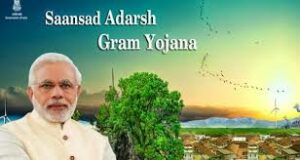
- Sansad Adarsh Gram Yojana is a rural development programme broadly focusing upon the development in the villages which includes social development, cultural development and spread motivation among the people on social mobilization of the village community.
- It aims to develop three Adarsh Grams by 2019, of which one would be achieved by 2016. Thereafter, five such Adarsh Grams (one per year) will be selected and developed by 2024.
- Gram Panchayat would be the basic unit for development. It will have a population of 3000-5000 in plain areas and 1000-3000 in hilly, tribal and difficult areas.
- Member of Parliament (MP) will identify one Gram Panchayat to be taken up immediately, and two others to be taken up a little later.
- Lok Sabha MP has to choose a Gram Panchayat from within his/her constituency and Rajya Sabha MP a Gram Panchayat from the rural area of a district of his/her choice in the State from which he/she is elected. Nominated MPs may choose a Gram Panchayat from the rural area of any district in the country.
- In the case of urban constituencies (where there are no Gram Panchayats), the MP will identify a Gram Panchayat from a nearby rural consitutency.
- The scheme will be implemented through a village development plan that would be prepared for every identified gram Panchayat.
- SAANJHI aims at instilling certain values, such as People’s participation, Antyodaya, gender equality, dignity of women, Social justice, spirit of community service, Cleanliness, eco-friendliness, maintaining ecological balance, Peace and harmony, mutual cooperation, Self-reliance, local self-government, o Transparency and accountability in public life, etc
Shyama Prasad Mukherji Rurban Mission (SPMRM)

- It aims to create 300 rural growth clusters across the country to: bridge the rural urban divide- economic, technological and those related to facilities and services, spread development in the region, attract investment in the rural areas,stimulate local economic development with emphasis on reduction of poverty and unemployment in rural areas.
- A ‘Rurban cluster’, would be a cluster of geographically contiguous villages with a population of about 25000 to 50000 in plain and coastal areas and with a population of 5000 to 15000 in desert, hilly or tribal areas.
- Clusters will be selected by the state governments. The State Government shall identify existing Central Sector, Centrally Sponsored and State Government Schemes relevant for the development of the cluster and converge their implementation in an integrated and time bound manner.
- Central Government shall provide Critical Gap Funding (CGF) to the clusters to supplement the shortfall in funding available through various Government schemes in achieving the outcomes.
- The scheme will function with 14 mandatory components to ensure an optimum level of development of a cluster, which include skill development training linked to economic activities, digital literacy, fully equipped mobile health unit and inter-village road connectivity.
Pradhan Mantri Gramin Awaas Yojana
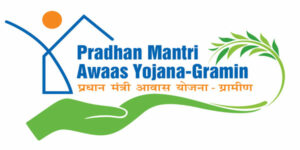
- The objective of the scheme is to provide a pucca house, with basic amenities, to all houseless householder and households living in kutcha and dilapidated house in rural areas by 2022. Immediate objective is to cover 1.00 crore households which are houseless or living in kutcha house/dilapidated house in three years from 2016-17 to 2018- 19.
Features of the Scheme:
- Unit assistance of 1.20 lakh in plain and Rs 1.30 lakh in hilly states, difficult areas and IAP district. Beneficiaries can also avail loan upto Rs. 7000 from financial institutions.
- Provision of assistance for toilets (Rs. 12000) for construction of toilets though convergence with Swacch Bharat Mission-Gramin, MGNREGS or any other dedicated the source of funding.
- The cost of unit assistance is to be shared between Central and State Government in the ratio 60:40 in plain areas and 90:10 for North Eastern and the Himalayan States.
- Beneficiary selection is to be done using housing deprivation parameters in the Socio Economic and Caste Census (SECC), 2011 to be verified by Gram Sabha.
- Beneficiary is entitled to 90/95 person day of unskilled labour from MGNREGS.
- It allows for construction using local materials and local house designs. The beneficiary to be assisted by in-house construction with house design typologies inclusive of disaster resilience features the are suitable to their local geo-climatic conditions.
- A pan-India training and certification programme of Masons has been launched in the States/UTs. The programme implementation is to be monitored through community participation (Social Audit), Member of Parliament (DISHA Committee), Central and State Government officials, National Level Monitors etc.
National Social Assistance Scheme
- Objective of the scheme is to provide support to aged persons, widows, disabled persons and bereaved families on death of primary bread winner, belonging to below poverty line households.
Presently it comprises of
- Indira Gandhi National Old Age Pension Scheme (IGNOAPS) : The eligible age for IGNOAPS is 60 years. The pension is Rs.200 p.m. for persons between 60 years and 79 years. For persons who are 80 years and above the pension is Rs.500/ – per month.
- Indira Gandhi National Widow Pension Scheme (IGNWPS) : The eligible age is 40 years and the pension is Rs.300 per month. After attaining the age of 80 years, the beneficiary will get Rs.500/ – per month.
- Indira Gandhi National Disability Pension Scheme (IGNDPS) : The eligible age for the pension er is 18 years and above and the disability level has to be 80%. The amount is Rs.300 per month and after attaining the age of 80 years, the beneficiary will get Rs 500/ – per month . Dwarfs will also be a n eligible category for this pension.
- National Family Benefit Scheme (NFBS) : 20000/ – will be given as a lumpsum assistance to the bereaved household in the event of death of the bread – winner.
- Annapurna Scheme : 10 kgs of food grains (wheat or rice) is given per month per beneficiary. The scheme aims at providing food security to meet the requirements of those eligible old aged persons who have remained uncovered under the IGNOAPS.













